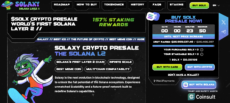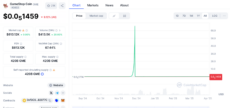President Trump’s embrace of crypto — from regulation reforms to personal ventures — is reshaping America’s digital future.
10 New Crypto Coins to Invest in 2025: Top New Cryptocurrencies
| Updatedby Tony Frank · 21 mins read

This guide is a must-read when exploring the best new crypto in 2025. We reveal the most promising launches to watch.
Disclaimer: Cryptocurrencies are considered high-risk investments. This article serves for informational purposes only. It should not be perceived as financial advice. By reading our website, you acknowledge and accept our terms and conditions. Our content may include affiliate links, through which we may earn a commission.
Millions of new cryptocurrencies are launched each month, providing both investment opportunities and risks. New cryptocurrencies differ from established ones like Bitcoin or Ethereum in that they lack price history and usually have small market capitalizations.
Only a small percentage of new launches are successful — but those that are can produce explosive returns. The remainder do the opposite, crashing in value and leaving holders with worthless digital assets.
This guide is a must-read when exploring the best new crypto in 2025. We reveal the most promising launches to watch, how to identify potential 100x gems, and what best practices to follow to ensure safety.
2025’s Hottest New Crypto Launches So Far
The most notable new crypto launches are listed below — their performance reflects broader market conditions:
| Coin | Ticker | Launch Date | Market Cap | Price Performance Since Launch | Key USP |
| OFFICIAL TRUMP | TRUMP | January 17th, 2025 | $2 billion | +49% | Official meme coin backed by Donald Trump |
| Berachain | BERA | February 6th, 2025 | $736 million | -40% | Cosmos-based layer-1 blockchain behind a huge airdrop |
| TRUMP GROK | GROK | April 4th, 2025 | $1.7 million | +284% | Base chain meme coin influenced by Donald Trump and Grok |
| Amnis Finance | AMI | March 26th, 2025 | $5 million | +52% | New DeFi staking platform for the Aptos ecosystem |
| Walrus | WAL | March 27th, 2025 | $696 million | +20% | Scalable storage solutions on the Sui blockchain |
Best New Crypto to Invest In
Let’s move on to new crypto projects launching in the coming weeks. These are presale cryptocurrencies, so you can make investments before the initial exchange listing.
1. Solaxy (SOLX) — Layer-2 Network for the Solana Ecosystem With Nearly $29 Million Raised
Solaxy (SOLX) is a utility-driven project building a layer-2 network for Solana. Its unique selling point is that tokens built on the Solana Program Library (SPL) benefit from streamlined efficiency —transactions are initially verified off-chain. This allows the main Solana blockchain to focus on security while Solaxy facilitates scalability and transaction fees.
Millions of SPL tokens exist (mainly new meme coins), so Solana does struggle with reliability during bullish markets. Transactions often fail, leaving speculative traders unable to buy or sell tokens. Solana’s network downtime has damaged its reputation, raising questions about its role in the Web 3.0 era.
Solaxy’s solution brings uncapped scalability, ensuring that increased activity doesn’t impact processing times or speeds.

Solaxy’s presale offers early access to SOLX, a new crypto token required when using its layer-2 solutions. Almost $29 million worth of SOLX has been bought, with prices increasing every few days.
The current price is $0.001682 per SOLX, and several cryptocurrencies are accepted for payment, including Ethereum (ETH), Tether (USDT), and Solana (SOL).
Key Points on Solaxy:
- A new layer-2 solution network for the Solana blockchain
- Transactions are initially verified off-chain without scalability caps
- Solaxy is pre-development, which vastly increases risk
- The ongoing presale is approaching $29 million
- SOLX will be listed on exchanges when the presale ends
2. BTC Bull Token (BTCBULL) — Deflationary Token With Real Bitcoin Airdrops on Key Pricing Milestones
BTC Bull Token (BTCBULL) has developed an innovative rewards framework based on the Bitcoin (BTC) price.
10% of the 21 million BTCBULL supply has been reserved for Bitcoin airdrops, distributed when pricing targets are met — a Bitcoin price of $150,000, $200,000, and every $50,000 until $1 million. Bitcoin rewards are proportionally distributed to anyone holding BTCBULL before the cut-off date.
BTC Bull Token’s deflationary design reduces the circulating supply over time. It achieves this through token burns whenever the Bitcoin price hits $125,000, $175,000, and so on (until $975,000).
Deflationary tokenomics are a popular feature with crypto whales — highly successful projects like BNB (BNB) have a similar structure.

The ongoing presale event is going strong, with over $4.3 million raised so far. BTC Bull Token has a staggered presale structure, with early buyers getting the lowest rate.
The presale price is currently $0.00245, but it will increase in three days. The accepted presale currencies are ETH and USDT, and no minimum investment is required.
Key Points on BTC Bull Token:
- Earn real Bitcoin airdrops based on key pricing milestones
- Rewards are paid until the Bitcoin price hits $1 million
- BTCBULL tokens are frequently burned, also related to Bitcoin prices
- Has raised over $4.3 million in presale funding
- Early presale investors get the lowest price
3. MIND of Pepe (MIND) — Revolutionary AI Agent With an Autonomous and Self-Sovereign Algorithm
MIND of Pepe (MIND) is a new crypto project from the artificial intelligence (AI) agent category. It operates in complete autonomy — project decisions are made without human input. MIND of Pepe develops self-evolving personalities from real-time data collection, shaping narratives based on existing digital asset trends.
MIND of Pepe uses broader sentiment to launch new tokens — not only on blockchains but also on decentralized exchanges (DEXs). This includes creating, auditing, and deploying smart contracts, with MIND holders benefiting from any future price increases.

Bloomberg reports that the AI agent industry is expected to grow significantly, so it’s no surprise that MIND of Pepe has raised almost $8 million in presale funding. Presale buyers earn 289% in staking rewards, although APYs decrease as demand grows. Accepted presale cryptocurrencies are ETH, USDT, BNB, and USDC Coin (USDC).
Key Points on MIND of Pepe:
- Innovative AI agent with a self-evolving personality
- Uses real-time data analysis to share narratives
- Operates autonomously, with the ability to launch new tokens
- Almost $8 million in presale funding to date
- Presale buyers earn 289% in staking APYs
4. Best Wallet Token (BEST) — Next-Gen Crypto Wallet Token With Multiple Ecosystem Perks
Best Wallet Token (BEST) backs the Best Wallet ecosystem, a fast-growing non-custodial app for storing and trading cryptocurrencies. Best Wallet created BEST to reward wallet users with ongoing perks, including reduced transaction fees and enhanced staking rewards. BEST holders also receive voting rights on project proposals.
The most notable use case is priority access to Best Wallet launchpads — an exclusive fundraising platform for new crypto tokens. The launchpad has a strict due diligence process, with only a small percentage being approved. BEST holders can invest in the first launchpad stage, meaning the lowest cost basis available.

Over $11.5 million has already been raised in Best Wallet Token’s ongoing presale (presales are similar to initial coin offerings). The current presale price is $0.024575 per BEST. Those unwilling to risk funds can join the airdrop campaign, which offers free BEST tokens when completing basic tasks.
Key Points on Best Wallet Token:
- Backs the Best Wallet ecosystem, a fully-fledged non-custodial wallet
- Holders have priority access to Best Wallet launchpad events
- Additional use cases include lower fees and enhanced staking rewards
- Doubles as a governance token, with holders voting on key proposals
- The presale has just passed $8.5 million in funding
5. Meme Index (MEMEX) — Decentralized Meme Coin Index Funds About to Launch on Uniswap
Meme Index (MEMEX) introduces the world’s first decentralized index funds for meme coins, offering market exposure with risk management best practices. Index funds are created based on specific criteria, such as trending narratives, market capitalization, and high-growth potential. Each meme coin is weighted accordingly and regularly rebalanced.
MEMEX, the new crypto token backing Meme Index, provides access to four index funds. Its value is influenced by the funds’ performance, loosely based on the net asset value (NAV). MEMEX holders also have governance rights. Votes are conducted on new index fund proposals, such as which meme coin market should be tracked.

Meme Index’s presale recently closed, with over $4.5 million raised. MEMEX’s initial exchange listing went live on April 2nd, 2025. It now trades on Uniswap with new listings planned. Investors should ensure MEMEX’s contract address is copied from the official website when trading — scammers are already impersonating Meme Index on social media.
Key Points on Meme Index:
- The world’s first index funds for meme coins
- Four funds have already been created, with more launching soon
- MEMEX must be held for market access
- Raised over $4.5 million in presale funding
- Uniswap is the token’s first exchange listing
How We Picked the Best New Crypto Projects to Watch
New crypto launches are beyond frequent — thousands of new tokens enter the market monthly. Most are created without any purpose and can be disregarded.
Choosing which new altcoins to buy remains challenging, so it’s crucial to follow a proven methodology. The following sections discuss key considerations when building a profitable portfolio.
Clear and Unique Use Cases
Most analysts agree that new cryptocurrencies should have a clear use case if they’re to succeed. This has never been more important, with CoinMarketCap data showing that over 13 million tokens now exist. Use cases ensure there’s a reason for the crypto token to be purchased rather than being another speculative bet.
A good example is Meme Index, which has developed the world’s first index funds for meme coins. MEMEX’s use case, its native token, is market access. Only MEMEX holders can invest in Meme Index baskets, providing a more realistic correlation between demand and price discovery.
Use cases, while important, should be realistic and verifiable. Many new projects make big claims about innovative products and services they’re working on. Whitepapers often present technical ambitions without any evidence that they exist. An early demo, Beta launch, or partnerships with crypto industry leaders are good signs that the use cases are legitimate.
Token Supply Dynamics
New crypto projects have unique supply dynamics, directly impacting their investability. Investors should focus on projects with capped supplies, preventing the creation of additional tokens and avoiding inflationary pressures. Capped supplies create scarcity, potentially increasing their value over time.
Investors should assess the circulating supply too — the percentage of tokens in the public domain. Consider a project with a 100 billion token supply but only 20 billion in circulation. 80% of the supply enters the market at some point, reducing the token’s appeal. This concept also applies to traditional equities, with new share issues often leading to stock price declines.

Evaluate the supply allocation as well — check what percentage of tokens the team allocates for day-to-day expenses, marketing, exchange listings, rewards, etc. A well-balanced supply distribution allows long-term sustainability, ensuring the team achieves its roadmap targets without burning through its operating capital.
Roadmap Progress and Objectives
New cryptocurrencies, similar to traditional startups, are often early-stage initiatives. They’re developing innovative ideas or concepts rather than having working products or services. Risk varies depending on progression — consider what’s already achieved and what remains in development. Projects with measurable progress within stated deadlines are a good sign, while those consistently missing roadmap targets are a red flag.
The team should also share roadmap progress on social media, updating investors on achievements, challenges, and expected completion. All startups face development setbacks — how they respond is what matters.
Market capitalization
Market capitalization — the total circulating tokens multiplied by market price — directly impacts risk and potential rewards. Most new cryptocurrencies have small market capitalizations, allowing investors to target significant gains. For example, a project valued at $1.5 million that grows 20x reaches a modest $30 million valuation.
20x growth is considerably more challenging for large-cap cryptocurrencies — substantial buying pressure is needed.
The trade-off is that small-cap cryptocurrencies are extremely volatile — large losses can occur in a short timeframe. Unlike large-caps, substantial selling pressure isn’t needed for a rapid market crash. Investors with lower risk appetites might prefer new cryptocurrencies with higher market capitalizations, reducing volatility but also limiting growth potential.
We included new cryptos to watch with various market capitalizations to suit different risk-reward profiles. High-risk, high-return investors will like presales — Solaxy, Meme Index, and BTC Bull Token, for instance, have small market capitalizations and a high upside potential. Larger capitalized projects like OFFICIAL TRUMP and Walrus are better suited to more risk-averse investors.
Exchange Listings
Most new cryptocurrencies trade on DEXs like Uniswap and Raydium. This reduces the token’s price potential — DEXs have much lower trading volumes and liquidity than centralized exchanges (CEXs) like Binance. Consider that Binance volumes were over $26 billion in the past day, compared to just $269 million on Raydium.
Cryptocurrencies on Binance have access to over 267 million traders too — giving new projects significantly more exposure.
Investors can manage risk and reward by evaluating new cryptocurrencies based on their exchange listings. Major exchanges typically don’t approve brand-new tokens due to increased volatility. They prefer established projects with high trading volumes, translating to higher commission revenues.
DEXs are the go-to option for discovering undervalued gems new to the market, so assessing your risk tolerance and trading goals is essential.
Crypto Narratives
Broader crypto markets tend to favor narratives representing specific crypto industries or use cases. A good example is AI cryptocurrencies — projects like Render, Bittensor, and Virtuals Protocol have seen substantial growth.
Another high-growth narrative is layer-2 networks. These projects provide infrastructure for existing blockchains, making ecosystems more scalable, cost-effective, and efficient. Solaxy sits within the layer-2 category — it streamlines transactions for Solana-based tokens, increasing reliability and throughput.
Investors can choose new cryptocurrencies from proven narratives or emerging sectors with future potential, like real-world assets (RWA), quantum computing, or green energies. Allocating funds across various niches ensures a well-balanced and diversified portfolio.
Initial Price Action
Seasoned investors analyze early price action when picking new cryptocurrencies to buy. Immediate price rallies after initial exchange listings are a good sign, showing the broader markets expect further growth.
However, investors should evaluate whether early price appreciation is based on hype or long-term potential. OFFICIAL TRUMP, for instance, increased by 10x within 48 hours of launching on Solana’s blockchain. Investors buying OFFICIAL TRUMP near its peak have since witnessed an 85% decline — this example reflects the speculative nature of meme coins.

Sustained rallies show stronger conviction from the markets, so consider new tokens with more established price growth to lower risk. This helps avoid hype cycles and promotes a more sustainable, profitable portfolio.
Benefits of Buying New Cryptocurrencies
We’ve discussed our methodology when picking new crypto coins with potential. Next, we’ll explore the benefits of buying new digital currencies.
Early Project Investors Get a First-Mover Advantage
First-mover advantage means investing early, backing new concepts and innovative technologies before the broader market catches on. Consider an investor buying Microsoft stock in 1986, long before computers became mainstream. Microsoft stock has increased by over 380,000% since its initial public offering (IPO) — providing early backers with substantial returns.
The same concept applies to new cryptocurrencies — investors risk funds on innovative solutions that haven’t been fully adopted. Early investors get market exposure at a more attractive price point, allowing long-term growth as the latest development milestones progress.
Target High Returns
Up and coming crypto projects often launch with low valuations, allowing investors to target high returns. A GlobalData report shows Ethereum’s market capitalization was just $80 million in 2015. Ethereum hit a $540 billion valuation in 2021 — a massive return for early adopters.
Cathie Wood, founder and CEO of ARK Invest, predicts a $20 trillion crypto market capitalization by 2032. This highlights the long-term growth potential when investing in new cryptocurrencies with strong fundamentals.
Another example is Solana, launching on exchanges in April 2020 at $0.67 per SOL. Solana hit an all-time high of $294.33 in January 2025 — a growth of 439x in under five years. Investors risking just $1,000 when Solana launched would have made $439,000 at the market peak. Solana was also available as a presale token, with early backers paying a reduced rate of $0.22. This increased the upside to 1,337x for presale buyers. We included presale projects like Solaxy and Best Wallet Token in our list for this reason.
Incentives for Early Investors
New crypto projects often provide incentives to early backers, helping them stand out in this highly crowded market. A common example is staking rewards, with huge APYs typically available during the initial few months. Meme Index, which recently launched on Uniswap after its successful presale, offers 505% APY. Investors can stake MEMEX tokens on Meme Index’s website, but APY will reduce as demand rises.

Price incentives are sometimes offered by new cryptocurrencies too — especially when investing in presale events. Many presale projects increase prices every few days, rewarding early backers with the lowest price.
Exclusive access to ecosystem features can also be reserved for early holders. One example is Best Wallet Token, which offers BEST holders priority access to new launchpad events. The key benefit is reduced token prices, a perk for speculative investors.
Broad Portfolio Diversification
New digital currencies are also beneficial for portfolio diversification. Investors have a significant choice — not only because of the sheer quantity of new launches but also the wide selection of industries and narratives. Diversification ensures that investors avoid becoming overexposed to any single project, which can mean significant losses if it isn’t successful.
A better strategy is investing in several different tokens from each selected category. Consider an investor with $5,000 who seeks exposure to new cryptocurrencies. They’re interested in five investing categories — RWA, layer-2 networks, meme coins, AI, and decentralized finance (DeFi). That investor could allocate $1,000 across several new projects from each category to reduce risk — while still offering exposure to high-growth markets.
Risks of New Crypto Launches
This section details the key risks of buying new cryptocurrencies and how to mitigate them effectively.
Many New Cryptocurrencies Are Pre- Or Mid-Development
Crypto launches are often brand-new projects in the pre- or mid-development stage. There are no guarantees that the utility offering, such as a new layer-1 blockchain or a DeFi ecosystem, will ever be built. Investors risk money believing a working product will eventually arrive, but operational challenges can prevent completion.
New projects often need vast resources to meet development targets, so one risk is that funds become depleted. Investors should factor these risks into the valuation, similar to investing in a growth stock from an emerging industry. New cryptocurrencies without any development evidence should have a much smaller market capitalization than those closer to a Mainnet launch.
High Volatility and Potential for Sharp Price Declines
All cryptocurrencies are highly volatile, particularly when compared to blue-chip stocks like Coca-Cola, Pfizer, and Microsoft. New crypto tokens present significantly greater volatility, especially when projects have small market capitalizations. This is due to market depth — the amount of traded dollars required to shift the market price by a certain amount.
Small-cap cryptocurrencies don’t require substantial buying or selling pressure to see large pricing swings. This is why new cryptocurrencies rise and fall much faster than established projects with bigger valuations.
The key takeaway is that investors can lose serious amounts when buying new cryptocurrencies. You should only risk amounts you’re prepared to lose.
Higher Probability of Investing in Scam Tokens
Most crypto scams happen in the early stages — a coin is launched hours ago, people start to buy it, and then the founder, developers, or other people in their network run with the money. Rug pulls are common scams — project founders build hype with fake promises only to withdraw liquidity from the DEX pool. The market price crashes, leaving investors with worthless tokens.
Investors can mitigate rug pull risks by verifying whether the liquidity pool has been locked and for how long. Founders are unable to withdraw liquidity during the lock period, so it’s a critical safeguard.
Pump and dump scams are also common with the newest crypto projects. Insiders artificially pump the token’s price, encouraging legitimate investors to buy — assuming they’ve found a potential gem. The founders eventually sell their tokens, profiting from victims and causing the price to crash.
Pump and dump risks are harder to mitigate, but the best practice is to avoid making investments purely because of price action. The better strategy is to focus on strong fundamentals like use cases and development progress.

Investors should also understand honeypot scams before buying new cryptocurrencies. The founders create a smart contract with malicious code — unidentifiable by the untrained eye. This allows them to perform functions that disadvantage existing investors, such as creating additional tokens above the capped supply (which can then be sold). Honeypots can also restrict holders from selling their tokens — that ability is only available to the founders.
The best way to avoid honeypot scams is to verify whether the smart contract has been audited. Reputable auditing companies can identify contract vulnerabilities so scammers avoid them. However, even audited smart contracts can be malicious, so they’re never a guaranteed safeguard against scams.
Broader Market Conditions
Broader market conditions have a major influence on price performance, particularly new cryptocurrencies with unproven or underdeveloped use cases. Bearish cycles, where sentiment is weak for extended periods, often result in most cryptocurrencies losing value — regardless of their fundamentals.
Investors should remember that risk-management principles like diversification can’t defend against market forces. Staying in the market long-term is the only way to avoid short-term volatility. Bitcoin declined from about $69,000 in late 2021 to under $16,000 a year later, only to hit an all-time high of $109,000 in January 2025. This shows that even the world’s most popular and valuable crypto witnesses extreme volatility.
How to Find New Crypto Coins
This section discusses the top strategies seasoned investors use to find new crypto coins coming out.
CoinMarketCap’s ‘Recently Added’
CoinMarketCap is the de facto website for crypto pricing data, boasting over 340 million monthly visitors. Thousands of new cryptocurrencies launch daily, but only a small percentage are added to CoinMarketCap’s database. The “Recently Added” section shows new cryptocurrencies in reverse chronological order — clicking one presents valuable crypto news and up-to-date information.
Investors can view the token dynamics, including the total and circulating supplies, network standard (e.g., ERC20), and the contract address. Pricing data, including market capitalization and volume, are also shown. CoinMarketCap also provides links to the project’s website so that investors can evaluate whitepapers and roadmaps independently.
Analyze On-Chain Data
On-chain data extracts information from the blockchain and presents it in an easy-to-view format. New cryptocurrencies appear on blockchain ledgers immediately after launching on DEXs, allowing investors to view them within seconds.
Several platforms provide on-chain data from multiple crypto ecosystems, including Birdeye, DEXTools, and DexScreener. These platforms are free, but premium features (like real-time tracking) require subscriptions. Investors should use the available filters to find potential projects, considering the sheer number of launches.
Birdeye filters, for instance, include price changes, market capitalization, holders, watchers, total supply, and volume. Specific blockchains can be targeted too, such as Solana, BNB Chain, Arbitrum, Ethereum, and Base.

Investors should create filters aligning with their risk appetite and goals. Risk-averse strategies should avoid new coins launched within the past few days — these come with higher volatility and increased risk of scams.
Explore Social Media for Trending Cryptocurrencies
Millions of investors use X, formerly Twitter, to find the next big crypto. Projects frequently trend on X before blowing up — potential signs include increased mentions, high engagement levels, and “Likes” or shares from influential people. Investors can search key terms like “new crypto”, focusing on posts with the most views and comments. This strategy should only be used as a baseline — independent research is crucial.
Reddit is also a valuable source when assessing potential crypto gems — its unique audience isn’t afraid to call out potential scams or unrealistic development targets, so check whether existing threads mention projects you’re interested in.
Existing and Upcoming Presales
New cryptocurrency releases use presales to raise funds — investors secure a first-mover advantage before exchange listings. Presales can be extremely high risk, as they’re often brand-new projects without proven use cases. There’s no pricing history either, so investors should proceed with caution.
That said, presales also present high-growth opportunities — most offer discounted prices and a micro-cap valuation. Many successful projects, including those with the largest market capitalizations, use presales before launching on exchanges. A good example is Ethereum — early-stage investors paid just $0.31 per ETH in 2014 — the ETH price hit almost $5,000 in 2021.
Conclusion
New coins are high-risk investments, but selecting projects with strong fundamentals can offer attractive long-term growth. Investors should avoid overexposure to any single token — a more risk-averse strategy is to build a diversified portfolio within the cryptocurrency landscape.
In our view, the best new crypto to buy is Solaxy, a layer-2 solution for Solana ecosystem tokens. Solaxy achieves faster and more scalable outputs by streamlining transactions off-chain. Solaxy’s presale is live, with about $29 million already raised.
FAQ
How often are new crypto coins released?
Thousands of new crypto coins are released monthly, resulting in highly oversaturated markets. User-friendly platforms now let anyone launch coins without programming knowledge.
What is the best new cryptocurrency to invest in?
The best new cryptocurrencies to invest in have strong fundamentals, including sustainable token supplies and innovative use cases.
Is it better to buy new cryptocurrencies?
New cryptocurrencies aren’t necessarily better — they’re suited to investors with high-risk appetites seeking big gains. Only a small percentage of new cryptocurrencies succeed, with most crashing to zero.
Are new cryptos risky?
Yes, new cryptos launching in 2025 are extremely risky. Most have small market capitalizations and unproven or underdeveloped use cases, making them highly volatile.
How do I find new cryptocurrencies before they launch?
Investors can find new cryptocurrencies via on-chain data platforms like Birdeye and DEXTools. Use filters (like market cap and holders) to find suitable projects.
Kalshi, a federally regulated prediction market, faces both opportunities and legal hurdles as it reshapes how users trade on real...
Coinbase is one of the most trusted cryptocurrency exchanges, offering intuitive access to digital assets. This guide covers every...